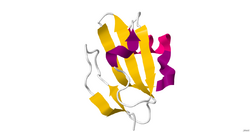Biology:LU domain
| u-PAR/Ly-6 domain | |||||||||||
|---|---|---|---|---|---|---|---|---|---|---|---|
 | |||||||||||
| Identifiers | |||||||||||
| Symbol | UPAR_LY6 | ||||||||||
| Pfam | PF00021 | ||||||||||
| InterPro | IPR001526 | ||||||||||
| PROSITE | PDOC00756 | ||||||||||
| CATH | 1erg | ||||||||||
| SCOP2 | 1erg / SCOPe / SUPFAM | ||||||||||
| CDD | cd00117 | ||||||||||
| |||||||||||
The LU domain (Ly-6 antigen/uPAR) is an evolutionarily conserved protein domain of the three-finger protein superfamily. This domain is found in the extracellular domains of cell-surface receptors and in either GPI-anchored or secreted globular proteins, for example the Ly-6 family, CD59, and Sgp-2.[2][3]
A variety of GPI-linked cell-surface glycoproteins are composed of one or more copies of a conserved LU domain of about 100 amino-acid residues.[4][5] Among these proteins, most contain only a single LU domain, though small numbers of exceptions are known; well-studied family member uPAR has three tandem LU domains.[3]
Structure
This domain folds into five antiparallel beta sheets, a structure common to the three-finger protein family. The domain typically contains ten well-conserved cysteine residues involved in five disulfide bonds, though some examples such as two of the three uPAR domains have fewer.[3]
Examples
Besides uPAR, other receptors with LU domains include members of the transforming growth factor beta receptor (TGF-beta) superfamily, such as the activin type 2 receptor;[6] and bone morphogenetic protein receptor, type IA.[7] Other LU domain proteins are small globular proteins such as CD59 antigen, LYNX1, SLURP1, and SLURP2.[2][8]
Subfamilies
- Urokinase plasminogen activator surface receptor InterPro: IPR003631
- Cell-surface glycoprotein Ly-6/CD59 InterPro: IPR003632
Human proteins containing this domain
ARS; CD177; CD59; LY6D; LY6E; LY6H; LYNX1; LYPD2; LYPD3; LYPD4; LYPD5; LYPD6; PLAUR; PSCA; SLURP2; SLURP1; SPACA4; TEX101;
Functions
Many LU domain containing proteins are involved in cholinergic signaling and bind acetylcholine receptors, notably linking their function to a common mechanism of 3FTx toxicity.[2][3][9] Members of the Ly6/uPAR family are believed to be the evolutionary ancestors of the three-finger toxin (3FTx).[10] Other LU proteins, such as the CD59 antigen, have well-studied functions in regulation of the immune system.[9]
References
- ↑ PDB: 2J8B; "High-resolution structures of bacterially expressed soluble human CD59". Acta Crystallographica. Section F, Structural Biology and Crystallization Communications 63 (Pt 8): 648–52. August 2007. doi:10.1107/S1744309107033477. PMID 17671359.
- ↑ 2.0 2.1 2.2 "The three-finger toxin fold: a multifunctional structural scaffold able to modulate cholinergic functions". Journal of Neurochemistry 142 (Suppl 2): 7–18. August 2017. doi:10.1111/jnc.13975. PMID 28326549.
- ↑ 3.0 3.1 3.2 3.3 "Organization, evolution and functions of the human and mouse Ly6/uPAR family genes". Human Genomics 10: 10. April 2016. doi:10.1186/s40246-016-0074-2. PMID 27098205.
- ↑ "The ligand-binding domain of the cell surface receptor for urokinase-type plasminogen activator". The Journal of Biological Chemistry 266 (12): 7842–7. April 1991. doi:10.1016/S0021-9258(20)89526-X. PMID 1850423.
- ↑ "Localization of the disulfide bonds in the NH2-terminal domain of the cellular receptor for human urokinase-type plasminogen activator. A domain structure belonging to a novel superfamily of glycolipid-anchored membrane proteins". The Journal of Biological Chemistry 268 (23): 17539–46. August 1993. doi:10.1016/S0021-9258(19)85366-8. PMID 8394346.
- ↑ "Three-finger toxin fold for the extracellular ligand-binding domain of the type II activin receptor serine kinase". Nature Structural Biology 6 (1): 18–22. January 1999. doi:10.1038/4887. PMID 9886286.
- ↑ "Crystal structure of the BMP-2-BRIA ectodomain complex". Nature Structural Biology 7 (6): 492–6. June 2000. doi:10.1038/75903. PMID 10881198.
- ↑ "The three-fingered protein domain of the human genome". Cellular and Molecular Life Sciences 65 (21): 3481–93. November 2008. doi:10.1007/s00018-008-8473-8. PMID 18821057.
- ↑ 9.0 9.1 "Three-finger snake neurotoxins and Ly6 proteins targeting nicotinic acetylcholine receptors: pharmacological tools and endogenous modulators". Trends in Pharmacological Sciences 36 (2): 109–23. February 2015. doi:10.1016/j.tips.2014.11.003. PMID 25528970.
- ↑ "From genome to "venome": molecular origin and evolution of the snake venom proteome inferred from phylogenetic analysis of toxin sequences and related body proteins". Genome Research 15 (3): 403–20. March 2005. doi:10.1101/gr.3228405. PMID 15741511.
 |

